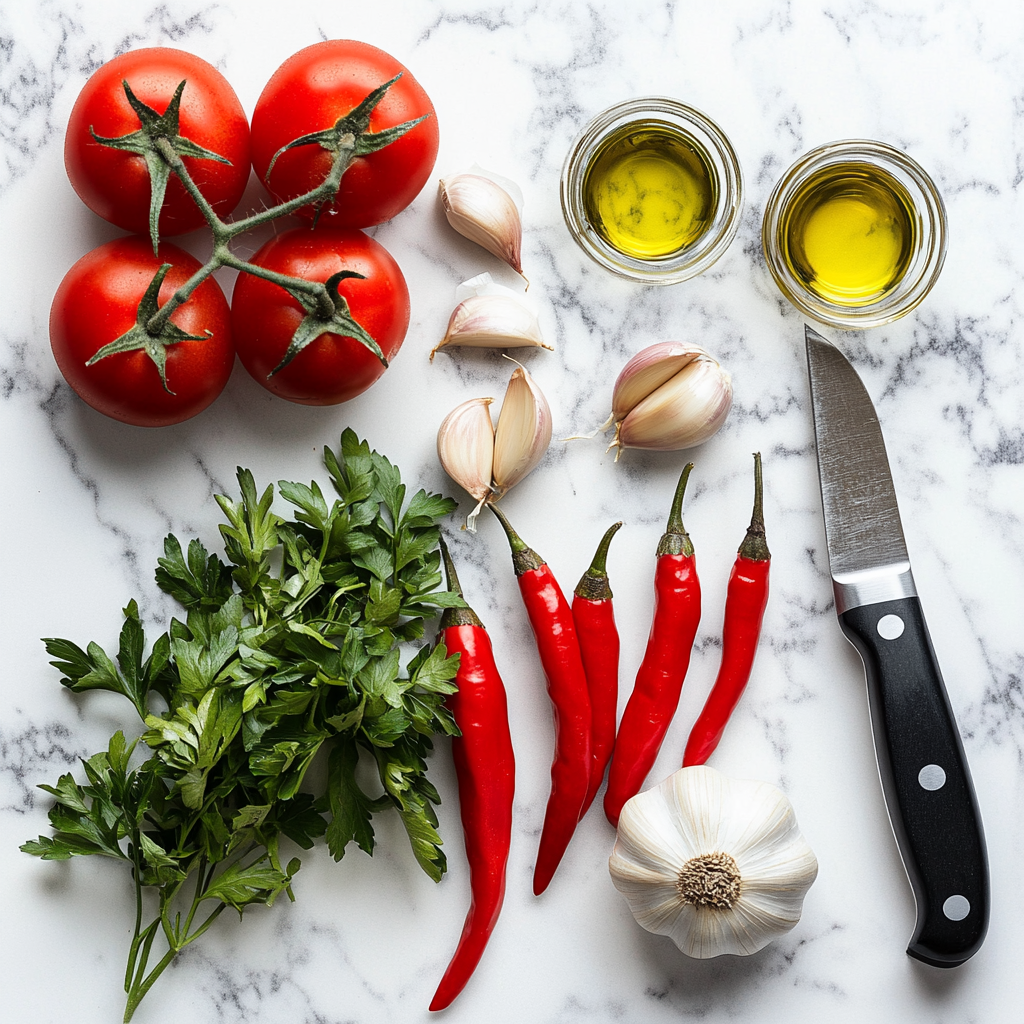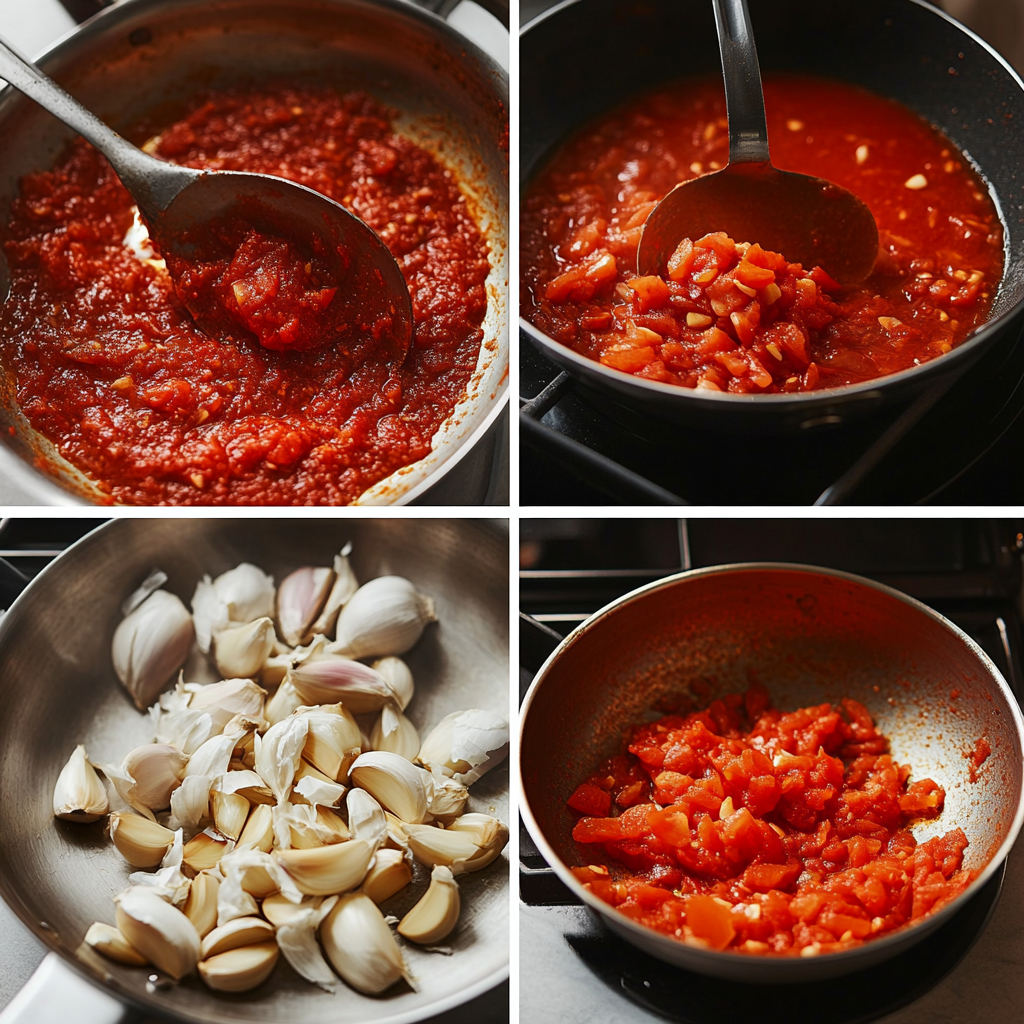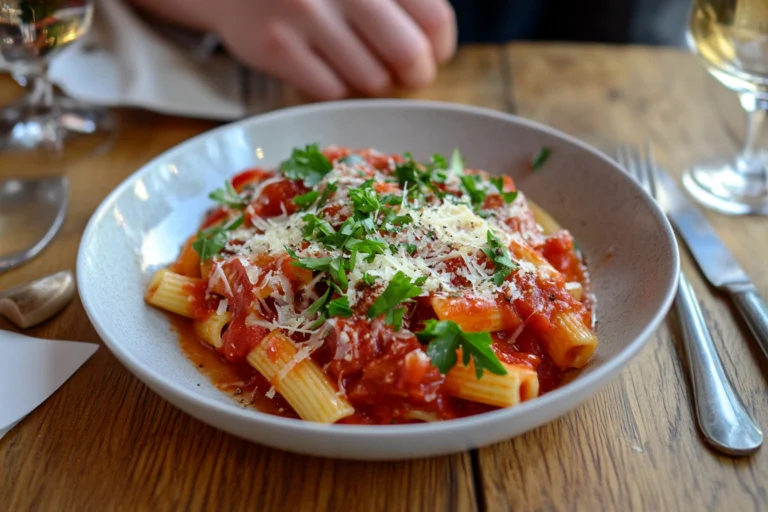Introduction
This spicy dish, full of strong flavors, is a beloved dish across Italy and beyond. But what does all’arrabbiata pasta actually mean? How did it earn its spicy reputation, and why is it so popular in Italian kitchens? In this article, we’ll uncover everything there is to know about this classic dish—its history, ingredients, preparation tips, and even its cultural meaning. So, let’s get started!
Table of contents
Understanding All’Arrabbiata Pasta
Definition of All’Arrabbiata
The term all’arrabbiata comes from Italian, meaning “angry” in English. But don’t worry, no one’s mad! The name refers to the spicy heat of the dish, thanks to its strong chili pepper base. This famous pasta is simple, yet full of flavor—a tasty mix of tomatoes, garlic, olive oil, and chili that perfectly balances sourness and heat. It’s a great example of how Italian cooking turns a few basic ingredients into something amazing.
Importance in Italian Cuisine
All’Arrabbiata pasta isn’t just a recipe; it’s a symbol of Italian cooking traditions. Originating from the Lazio region, especially Rome, it’s known for its simple, home-style preparation. Italians love it for its strong flavors and its flexibility—it’s a go-to dish for quick dinners, family gatherings, or even late-night cravings. Its popularity has spread far beyond Italy, with fans all over the world enjoying its spicy taste.
Etymology and Meaning
Origin of the Term ‘All’Arrabbiata’
The name all’arrabbiata has a special charm in the Italian language. It comes from the word “arrabbiato,” which means “angry” or “mad.” The dish’s spicy reputation reflects this mood, as the heat from red chili peppers makes the sauce so hot, it’s as if the sauce itself is “angry.” While its exact beginnings are debated, all’arrabbiata pasta has become a well-known dish in Rome and the Lazio region.
Literal Translation
In Italian, all’arrabbiata literally means “in the angry style.” This colorful description shows the fiery and passionate nature of the sauce. Its heat might make you tear up—just like anger might—but in the most enjoyable and flavorful way.
Cultural Significance
For Italians, all’arrabbiata pasta is more than just a dish. It shows their way of making something amazing from simple ingredients. The dish is a common item in Roman trattorias, where it’s often eaten with lively talk and laughter. Its spicy kick also represents the lively and exciting culture of Italy, celebrating boldness and energy in both life and food. With its worldwide popularity, all’arrabbiata pasta now serves as a tasty symbol of Italian tradition.
Historical Background
History of All’Arrabbiata Sauce
All’Arrabbiata sauce has a long history tied to Italian cooking traditions. Coming from the Lazio region, especially Rome, this sauce became a symbol of simple yet strong flavor. It’s thought to have started in the 18th or 19th century when tomatoes became common in Italy. The use of chili peppers, brought to Europe from the Americas, gave it a spicy kick, setting it apart from other tomato-based sauces. This simple but tasty dish quickly became popular for its easy preparation and unforgettable flavor.
Over time, all’arrabbiata has become a regular dish in Italian homes and restaurants, staying popular as a quick and comforting meal for any occasion. It’s loved not just for its taste but also for showing Italian cooking creativity.
Regional Origins in Italy
The Lazio region is where all’arrabbiata sauce was first made. Romans loved its spicy taste, adding it to their daily meals. The dish was especially popular with working people, thanks to its cheap ingredients. Today, it’s a key dish in Roman trattorias, reflecting the region’s love for strong, lively flavors.
Evolution Over Time
While the basic recipe has stayed the same, all’arrabbiata sauce has had some small changes over time. Some cooks have tried adding fresh herbs like parsley, while others have added a little grated pecorino cheese for extra flavor. Around the world, the dish has inspired new versions, from milder recipes to ones that mix in local flavors. Even with these changes, the heart of all’arrabbiata—its simplicity and boldness—remains the same, keeping its lasting popularity.
Traditional Ingredients
Key Components of All’Arrabbiata Sauce
The beauty of all’arrabbiata sauce lies in its simplicity, using just a few fresh, bold ingredients. Each part plays an important role in creating the dish’s spicy, tangy, and fragrant flavor. By sticking to these basic ingredients, the sauce gives an authentic taste that stays true to its Italian roots.
Tomatoes
Tomatoes are the main part of all’arrabbiata sauce. Traditionally, ripe plum tomatoes or canned San Marzano tomatoes are used for their natural sweetness and strong flavor. They’re cooked down into a thick base that perfectly balances the heat from the chili. The quality of tomatoes is very important for this dish.
Garlic
Garlic is the fragrant base of this sauce. It’s gently cooked in olive oil to bring out its flavor without making it too strong. This adds a subtle depth and brings out the savory taste, blending perfectly with the tomatoes and chili.
Red Chili Peppers
The key part of all’arrabbiata sauce, red chili peppers, bring the spice. Whether fresh or dried, they’re sliced or crushed to give the sauce a spicy kick. The spice level can be changed to match personal taste, but the dish’s “angry” reputation needs bold heat.
Olive Oil
Good-quality extra virgin olive oil is important for cooking the garlic and chili. It gives the sauce a smooth texture and a fruity, slightly peppery flavor. The oil also helps spread the flavors throughout the dish, making every bite full of taste.
Optional Additions (e.g., Parsley, Pecorino Cheese)
While the traditional recipe is simple, optional ingredients like fresh parsley or grated pecorino cheese can make the dish even better. Parsley adds a fresh, herby taste, while pecorino cheese gives a salty richness that balances the heat. These additions are popular but not necessary.

Preparation Method
How to Make Authentic All’Arrabbiata Sauce
Making all’arrabbiata sauce at home is a simple but rewarding experience. The process needs fresh ingredients and a bit of care to bring out the bold, spicy flavors that make the dish special. Whether you like a mild or extra-spicy sauce, this recipe lets you customize it while keeping its true essence.
Step-by-Step Cooking Instructions
- Heat the Olive Oil: Start by warming two tablespoons of extra virgin olive oil in a large pan over medium heat.
- Sauté Garlic and Chili: Add two finely sliced garlic cloves and one or two crushed red chili peppers (adjust to your taste). Cook gently until the garlic turns golden, but not brown, so the flavors can come out.
- Add the Tomatoes: Stir in a can of good-quality San Marzano tomatoes, smashing them with a spoon. Let the sauce cook for 10-15 minutes until it thickens.
- Season and Adjust: Add a pinch of salt and freshly ground black pepper. Taste and tweak the spice level by adding more chili if desired.
- Combine with Pasta: Mix the sauce with freshly cooked pasta, making sure each piece is coated well. Serve hot, and add fresh parsley or grated pecorino cheese if you like.

Common Variations
Some variations of all’arrabbiata sauce include extra ingredients to improve the flavor. For example, some chefs add a little vegetable stock to make the sauce richer or a pinch of sugar to balance the sourness of the tomatoes. A milder version might use less chili, while creative cooks try adding roasted bell peppers for a smoky flavor. Even with these changes, the main idea of the dish—a bold, spicy tomato sauce—stays the same.
Pasta Pairings
Best Pasta Types for All’Arrabbiata Sauce
The fiery, tangy all’arrabbiata sauce pairs best with pasta that complements its bold flavors while holding the sauce beautifully. In fact, traditional and alternative pasta choices ensure this versatile dish can suit any palate or occasion.
Traditional Choices (e.g., Penne)
Penne is the classic choice for all’arrabbiata pasta. Its tubular shape and ridges are perfect for trapping the spicy sauce, ensuring each bite is flavorful. As a result, the sauce clings effortlessly to penne, making it the go-to option in Roman kitchens and beyond. Additionally, other traditional short pasta shapes, such as rigatoni or ziti, also pair well for similar reasons.
Alternative Options
While penne is iconic, long pasta varieties like spaghetti or linguine offer a different yet delightful experience. These shapes, in particular, allow the sauce to coat the noodles evenly, delivering a luscious, fiery flavor in every forkful. Moreover, for a healthier twist, some opt for whole-grain or gluten-free pasta, which pairs excellently with the robust sauce. Ultimately, any pasta that holds the sauce well can be a great companion to all’arrabbiata.
Nutritional Information
Health Aspects of All’Arrabbiata Pasta
All’arrabbiata pasta is not only delicious but also relatively nutritious, especially when prepared with fresh, wholesome ingredients. This dish is low in fat and packed with flavors, making it a satisfying option for those watching their calorie intake or looking for a meat-free meal.
Calorie Content
A serving of all’arrabbiata pasta typically contains around 350–400 calories, depending on portion size and additional ingredients like cheese. The sauce itself is low-calorie, as it relies on tomatoes, garlic, and chili for its flavor, making it a lighter choice compared to cream-based sauces.
Macronutrient Breakdown
The dish primarily provides carbohydrates from the pasta, moderate amounts of fat from the olive oil, and a small amount of protein. Adding grated pecorino cheese or pairing the dish with protein-rich sides can make it more balanced nutritionally. For a healthier alternative, whole-grain pasta adds fiber.
Health Benefits and Considerations
The tomatoes in all’arrabbiata sauce are rich in antioxidants like lycopene, which supports heart health and reduces inflammation. Garlic and chili peppers bring additional health perks, including improved digestion and metabolism. However, those sensitive to spice should moderate the chili content. For gluten-free or lower-carb diets, alternative pasta options can be used without sacrificing flavor.
Cultural Impact
All’Arrabbiata in Popular Culture
This fiery pasta dish is more than a recipe—it’s a cultural symbol that has transcended its Italian roots to capture global imagination. Its bold flavors and accessible preparation have secured its place in culinary and pop culture alike.
Appearances in Films and Media
All’arrabbiata pasta has made memorable appearances in films, TV shows, and books that highlight Italian cuisine. Its simplicity and charm often serve as a metaphor for rustic, authentic living. From romantic Italian dinner scenes to cooking shows showcasing its preparation, all’arrabbiata represents the passion and vibrancy of Italy.
Role in Italian Culinary Traditions
In Italy, all’arrabbiata is more than just a meal—it’s a celebration of bold, uncomplicated flavors. Often enjoyed at casual family gatherings or in bustling Roman trattorias, this dish embodies the essence of Italian cooking: minimal ingredients, maximum taste. Its spicy kick also mirrors the lively, fiery spirit of Italian culture, making it an enduring favorite worldwide.
Global Variations
International Adaptations of All’Arrabbiata Sauce
As all’arrabbiata sauce traveled beyond Italy, it adapted to suit the tastes and culinary traditions of different cultures. While the core elements of tomatoes, garlic, chili, and olive oil remain consistent, regional tweaks add exciting new dimensions to this classic dish.
Regional Twists Outside Italy
In the United States, variations of all’arrabbiata sauce often include extra herbs like basil or oregano to cater to local preferences. Some American recipes tone down the heat, replacing fresh chili peppers with mild red pepper flakes. In Mediterranean countries, olives or capers are sometimes added to give the dish a salty, briny note, blending the boldness of all’arrabbiata with local flavors.
Fusion Recipes
Fusion chefs around the world have reimagined all’arrabbiata sauce in creative ways. In Asian-inspired versions, chili oil or even a touch of soy sauce is added for umami depth. Vegan adaptations often include roasted vegetables for added heartiness. In South America, some cooks incorporate smoky chipotle peppers to give the dish a unique, fiery twist while maintaining its signature spice.
Cooking Tips
Expert Advice for Perfecting All’Arrabbiata Sauce
Making all’arrabbiata sauce may seem straightforward, but small details can elevate it from good to unforgettable. With these tips, you can achieve the perfect balance of flavor and spice every time.
Balancing Spice Levels
The heat in all’arrabbiata is central to its charm, but not everyone enjoys the same level of spiciness. To control the heat, start with a small amount of chili and adjust gradually as you taste. Removing the seeds from fresh chili peppers can significantly reduce the spiciness without sacrificing flavor. For those who enjoy a milder dish, sweet paprika can be a flavorful alternative.
Enhancing Flavor Depth
For a richer, more complex sauce, consider layering flavors. Sautéing the garlic and chili in olive oil slowly over low heat prevents burning and enhances their aromatics. Use high-quality canned tomatoes or fresh, ripe ones for a robust base. Adding a splash of reserved pasta water while simmering the sauce helps thicken it and melds the flavors together beautifully. For a finishing touch, drizzle a little fresh olive oil over the pasta before serving—it’s a small step that adds an incredible depth of flavor.
Serving Suggestions
Ideal Accompaniments for All’Arrabbiata Pasta
All’arrabbiata pasta is a standalone delight, but pairing it with complementary sides elevates the dining experience. From fresh salads to crusty bread, the right accompaniments highlight the dish’s bold flavors while adding variety to the meal.
Side Dishes
Fresh, crisp salads, like an arugula and cherry tomato mix with a light vinaigrette, balance the spice of all’arrabbiata. Garlic bread or bruschetta provides a satisfying crunch and a way to scoop up extra sauce. For a heartier meal, roasted vegetables, such as zucchini or eggplant, pair beautifully with the pasta’s tangy, spicy flavor.
Wine Pairings
While all’arrabbiata is traditionally paired with bold red wines, non-alcoholic alternatives like sparkling water with a hint of citrus also work well. The acidity in these options complements the tomatoes, while their freshness balances the chili’s heat. These pairings ensure a harmonious and flavorful meal without overpowering the pasta.
Common Mistakes to Avoid
Pitfalls in Preparing All’Arrabbiata Sauce
Even a straightforward recipe like all’arrabbiata has its pitfalls. Avoiding common mistakes ensures your sauce is perfectly balanced and packed with flavor.
Overcooking or Undercooking Ingredients
Sautéing garlic and chili too quickly can lead to bitterness, while undercooking the tomatoes may result in a watery, unbalanced sauce. Always cook garlic and chili over low heat to release their flavor gently, and simmer the tomatoes until the sauce is thick and rich for the best results.
Improper Spice Balance
Getting the spice level right is crucial. Too much chili can overwhelm the dish, while too little might lose its fiery charm. Start small and taste frequently, adjusting as needed. Removing chili seeds or adding a touch of sugar can help tame excessive heat without compromising the sauce’s essence.
Frequently Asked Questions (FAQs)
FAQs About All’Arrabbiata Pasta
What does ‘all’arrabbiata’ mean in Italian?
The term all’arrabbiata translates to “angry” in Italian, referring to the sauce’s fiery heat from the chili peppers. This “angry” flavor profile is a defining characteristic of the dish, making it a bold and spicy favorite in Italian cuisine.
Is all’arrabbiata sauce very spicy?
Yes, all’arrabbiata sauce is known for its spiciness, but the heat level can vary depending on the amount and type of chili used. Traditional recipes call for a noticeable kick, but it’s easy to adjust the spice level to suit individual tastes.
Can I make all’arrabbiata sauce ahead of time?
Absolutely! All’arrabbiata sauce can be made in advance and stored in the refrigerator for up to three days. Reheating it gently over low heat before serving helps retain its bold flavors. It can also be frozen for longer storage.
Is Arrabiata pasta very spicy?
Arrabiata pasta is famous for its spiciness, but the heat level varies depending on the amount of chili used. Typically, chili flakes provide a strong, fiery heat, balanced by the smooth tomato sauce. However, those who don’t enjoy too much spice can reduce the heat by using fewer chili flakes or milder peppers. The defining characteristic of this dish comes from its spicy intensity.
What does Arrabiata sauce go with?
Arrabiata sauce pairs well with a variety of pasta types, including penne, spaghetti, and rigatoni. The chunky texture of the sauce sticks to the pasta, creating a satisfying meal. It can also serve as a base for other dishes, like grilled chicken, shrimp, or roasted vegetables, adding a spicy kick. Additionally, it can be enjoyed with crusty bread for an extra touch.
What is the difference between Arrabiata sauce and spaghetti sauce?
Arrabiata sauce is a specific type of Italian tomato sauce that is known for its heat, usually made with garlic, chili flakes, and olive oil. In comparison, spaghetti sauce (also called marinara sauce) is usually milder and can contain a wider range of ingredients such as onions, herbs like basil and oregano, and sometimes meat. The key difference between the two is that Arrabiata sauce is much spicier, while spaghetti sauce is more savory and smooth in flavor.
Conclusion
Recap and Final Thoughts on All’Arrabbiata Pasta
All’arrabbiata pasta is much more than a spicy dish—it’s a celebration of simplicity, bold flavors, and Italian culinary artistry. From its humble origins in Rome to its global adaptations, it remains a timeless favorite that brings warmth and excitement to the table. By understanding its history, ingredients, and preparation tips, you can easily enjoy this fiery classic at home. Whether you’re a spice enthusiast or just exploring Italian cuisine, all’arrabbiata pasta is sure to leave a lasting impression with every bite.

